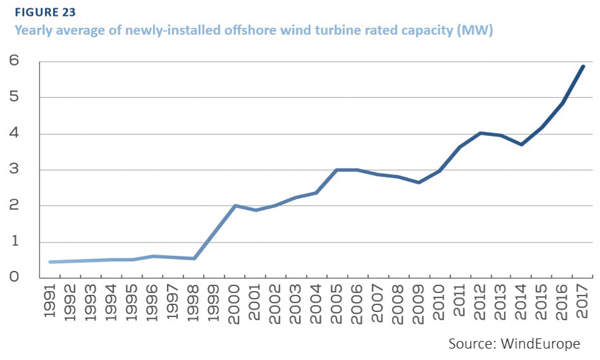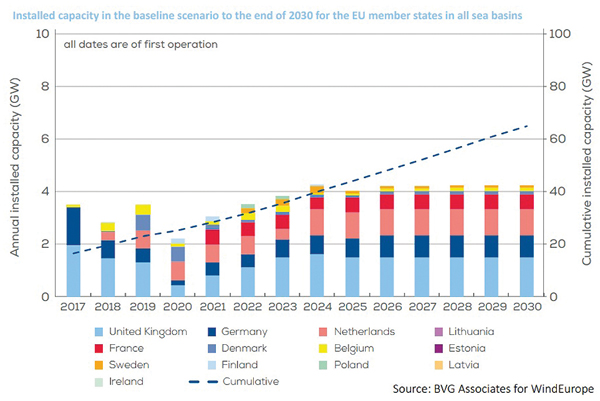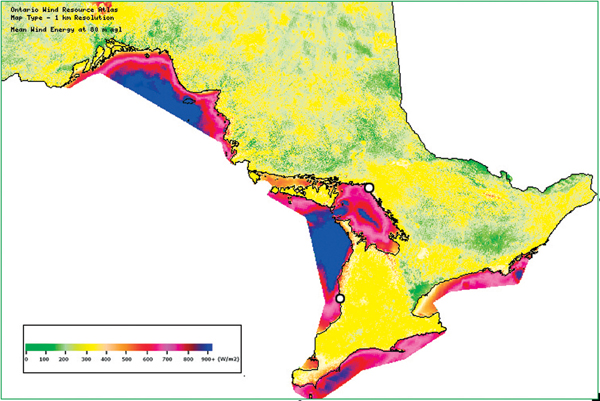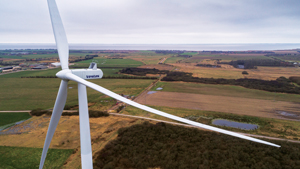By Stephen Kishewitsch
Technological improvements are doing more than bringing down the cost of wind power. Steady improvements in design, materials and manufacture, in both turbine components and storage, have been making it possible for commercial wind power to gain new access in market segments at both the large and small ends of the market. The growth in average turbine size, thanks to ever-larger blades and generators with ever-higher ratings, has been remarkable over the past decade, showing up particularly in offshore wind proposals. Trials have even begun in the UK to test whether adjusting the pitch and yaw of turbines at the upwind side of a wind farm to control their downwind wake can increase total production from the windfarm as a whole.
Some recent developments are indicative, at the large end of the scale:
• Three windpower projects are in the process for offshore wind supply for Massachusetts:
 Bay State wind location
» Bay State Wind, a proposed 400-800MW offshore wind project approximately 15-25 miles south of Martha’s Vineyard, has been designated as a covered project under Title 41 of the Fixing America’s Surface Transportation Act (FAST-41). A company representative said the supplier for the turbines is still confidential information, but turbine size will be in the 6-10 MW range.
Bay State wind location
» Bay State Wind, a proposed 400-800MW offshore wind project approximately 15-25 miles south of Martha’s Vineyard, has been designated as a covered project under Title 41 of the Fixing America’s Surface Transportation Act (FAST-41). A company representative said the supplier for the turbines is still confidential information, but turbine size will be in the 6-10 MW range.
The project will include 55 MW of lithium-ion battery storage, which the company says will be the largest battery storage system ever deployed in conjunction with a wind farm.
» Vineyard Wind, an 800MW offshore wind farm also south of Martha’s Vineyard, is to consist of an array of wind turbines, each capable of generating over 8 MW of power. Site construction is set to begin in 2019.
» Deepwater Wind unveiled plans for its Revolution Wind in July of 2017, a 24-unit, 144 MW (6 MW each) wind farm, also offshore Massachusetts. The project proposal includes a 40 megawatt-hour battery storage system provided by Tesla energy storage system. The wind farm would be adjacent to Deepwater Wind’s South Fork Wind Farm, a 90 MW project serving Long Island. The State of Massachusetts has passed over the project for now, but the company plans to apply again under a separate request for proposals.
The company is also in the early stages of development of its South Fork Wind Farm – a 90 MW project scheduled to begin serving Long Island in 2022 – as well as the Skipjack Wind Farm – a 120 MW project on schedule to begin serving Maryland in late 2022. The company’s 30MW Block Island Wind Farm in Rhode Island began commercial operations in December 2016.
• An April 2017 article in Power Engineering says average rotor diameter is expected to reach 135 meters. Siemens has a machine with rotor diameter of 142 meters currently on offer for onshore use. LM Wind Power, at the time, made and may still make the world’s longest blade, at 88.4 metres. Hub heights have grown as well. The current average height on land of 82 meters is expected to give way to an average of 115 meters in 2030.
 Average turbine capacity for offshore installs Source: WindEurope (February 2018).
• The average capacity rating of installed offshore turbines rose around 62% between 2006 and 2016, according to WindEurope data. Another report from WindEurope saw the capacity of newly-installed offshore wind turbines rise from 4.8 MW in 2016 to 5.9 MW in 2017. In 2017 Orsted became the first offshore wind farm developer to install 8 MW turbines and the company has predicted turbines of 13 to 15 MW will be on the market by 2024. On March 1, GE announced a new entry at the giant end of the scale, its 12 MW Haliade-X. GE says “the combination of a bigger rotor, longer blades and higher capacity factor makes Haliade-X less sensitive to wind speed variations, increasing predictability and the ability to generate more power at low wind speeds.”
Average turbine capacity for offshore installs Source: WindEurope (February 2018).
• The average capacity rating of installed offshore turbines rose around 62% between 2006 and 2016, according to WindEurope data. Another report from WindEurope saw the capacity of newly-installed offshore wind turbines rise from 4.8 MW in 2016 to 5.9 MW in 2017. In 2017 Orsted became the first offshore wind farm developer to install 8 MW turbines and the company has predicted turbines of 13 to 15 MW will be on the market by 2024. On March 1, GE announced a new entry at the giant end of the scale, its 12 MW Haliade-X. GE says “the combination of a bigger rotor, longer blades and higher capacity factor makes Haliade-X less sensitive to wind speed variations, increasing predictability and the ability to generate more power at low wind speeds.”
 Europe offshore wind capacity forecast. Source: BVG Associates for WindEurope (2017).
The International edition of The Guardian reported recently that a 150m tall wind turbine built this year in Australia will generate energy for almost 3,000 average Victorian homes. A decade ago, a top-tier turbine would have generated less than half as much.
Europe offshore wind capacity forecast. Source: BVG Associates for WindEurope (2017).
The International edition of The Guardian reported recently that a 150m tall wind turbine built this year in Australia will generate energy for almost 3,000 average Victorian homes. A decade ago, a top-tier turbine would have generated less than half as much.
Not only do size categories like this make it possible to harvest ever more energy from high-value resource areas like offshore, higher capacity turbines require less maintenance resources per MW, reducing the outlay for spare parts, vessels and personnel during operations. Bloomberg New Energy Finance has estimated that increasing turbine capacities directly bear upon as much as 60% of a windfarm’s operation and maintenance costs.
 US wind, hydro capacity & output forecast
Driven by such trends, the United States Energy Information Administration (EIA) forecast in late January that U.S. installed wind power capacity would rise by 8.3 GW in 2018, resulting for the first time in a higher figure for annual generation from wind than from hydropower.
US wind, hydro capacity & output forecast
Driven by such trends, the United States Energy Information Administration (EIA) forecast in late January that U.S. installed wind power capacity would rise by 8.3 GW in 2018, resulting for the first time in a higher figure for annual generation from wind than from hydropower.
At the other end of the scale is small and micro wind – a few tens of kilowatts, down to half a kW or less.
IPPSO FACTO has carried stories from time to time about turbines developed for applications as small as residential rooftops. Some have had a record of proving to be poor investments, despite being aggressively promoted, and the field has languished compared to the other end of the scale. Some suppliers grew too fast and then folded. More recently, qualified certification has become available for well-designed machines, but expert opinion has generally turned away from the idea that such applications can be cost-effective in areas with good supply from the grid. Their proper place is considered to be in remote, off-grid locations, and a handful of companies remain or have stepped into the gap. For example:
• Eocycle, in Montreal, whose EO20 and EO25 wind turbines are rated at 20 and 25 kW.
• Northern Power Systems, in Vermont, which offers a 100 kW and a 60 kW turbine, using a 21 or 24 metre rotor, that begins generating power at wind speeds down to 3 metres per second.
Typical designs for such turbines are larger swept area and improved airfoil design that allows a wind cut-in speed down to 2.5 metres/second, a direct-drive permanent magnet generator to eliminate weight and mechanical issues related to gearboxes, and in the case of Eocycle the option of a tower that can be laid flat for assembly and maintenance and hydraulically erected.
But while the 10 MW plus machines are spectacular, and skillful engineering on those at the other end of the scale may find increasing application, freeing remote communities from polluting diesel generation, it may be those in the unglamorous middle where the largest differences are being realized through technical innovation.
Most of the world, apart from sites by large bodies of water or at high elevation, has only a modest wind resource. Rather than seeking out the dramatic (and remote and expensive) locations to build windfarms, the argument goes, it would make sense to try and make better use of the much more common (and accessible) medium winds, that blanket, for example, most of Ontario.
Engineers and manufacturers are beginning to be able to do that, says longtime wind analyst and proponent Paul Gipe. These improvements can be credited to steady, modest enhancements rather than large scale breakthroughs.
“It’s not about big leaps forward, Gipe comments in his Wind-Works blog: “It’s not VAWTs [vertical-axis wind turbines], DAWTs [diffuser-augmented wind turbines], or other flashy new inventions that’s revolutionizing wind energy. It’s boring refinements of existing technology that’s making wind energy more economical in more places than ever before.
 Mean wind energy in southern Ontario at 80 metres above ground level. Over almost all of the province, except for on and adjacent to the Great Lakes, the wind resource is modest to low. Ontario Wind Resource Atlas.
“Ontario has generally very modest wind resources, except for areas like Goderich and the lakes themselves. (Goderich is the location of the Kingsbridge and K2 windfarms, on Lake Huron. Henvey Inlet windfarm, under development, is on the north shore of Georgian Bay. Both are indicated by white circles on the map, and clearly benefit from the higher wind regimes on the lakes.)
Mean wind energy in southern Ontario at 80 metres above ground level. Over almost all of the province, except for on and adjacent to the Great Lakes, the wind resource is modest to low. Ontario Wind Resource Atlas.
“Ontario has generally very modest wind resources, except for areas like Goderich and the lakes themselves. (Goderich is the location of the Kingsbridge and K2 windfarms, on Lake Huron. Henvey Inlet windfarm, under development, is on the north shore of Georgian Bay. Both are indicated by white circles on the map, and clearly benefit from the higher wind regimes on the lakes.)
“What you need to capture a lot of energy is a really big rotor – it’s not the generator. We need bigger rotors for areas with modest wind. In the beginning of the industry, wind turbines were designed for high-wind areas, mountaintops and coastal areas, so they would have a big generator on a relatively small rotor, to get as much energy out of the high winds. Now we’re going into a new market, areas of less and less wind. The way to make that cost-effective is to capture that with a bigger rotor – the same wind energy, just a bigger rotor. In Indiana they’ve put in hundreds of wind turbines that are only 1.5 MW, but with rotors 50% larger than what you have in Ontario – say 120 meters in diameter versus 80 meters. In those areas, high winds don’t occur often enough to justify a large generator, and when they do you can just turn them off; the potential loss of power generation isn’t frequent enough to be important. And it’s not just the generator, it’s the entire assembly that can be built more lightly and less expensively if the rotor can be set to not respond.”
 Vestas 120-2.0, with its longer blades.
Supporting Mr. Gipe’s thesis, the Power Engineering article mentioned above also notes that blade lengths have also been increasing for turbines rated at 2 and 3 MW. The same 2 MW class turbine that would have been installed some years ago, with an 83-meter rotor, can now have a 120-meter rotor. Siemens’ 3-MW class direct-drive turbine now sports both a 130-meter rotor and 142-meter rotor, the article says.
Vestas 120-2.0, with its longer blades.
Supporting Mr. Gipe’s thesis, the Power Engineering article mentioned above also notes that blade lengths have also been increasing for turbines rated at 2 and 3 MW. The same 2 MW class turbine that would have been installed some years ago, with an 83-meter rotor, can now have a 120-meter rotor. Siemens’ 3-MW class direct-drive turbine now sports both a 130-meter rotor and 142-meter rotor, the article says.
“As a result, we can put the wind turbines where the people are, not where the big winds are, and reduce the transmission expenditures and losses.”
“The exciting story behind these new wind turbines is that they are both more cost effective and also better able to use scarce transmission capacity, [which makes them] easier to integrate into the existing grid than those of only a few years ago.”
(To illustrate Paul Gipe’s point, EWT’s 250 kW offering, for example, has a rotor diameter of 54 metres and a cut-in speed of 2.5 m/sec. The Vestas 2 MW V80, used in the Kingsbridge windfarm, rated 8x higher, has a rotor diameter of 80 metres and an cut-in speed of 4 m/sec.)
“In combination with other sources of renewable energy, these new wind turbines allow engineers and policy makers to begin considering how to design power systems with 100% renewable energy. Some are now even calling for systems for 200% or 300% renewable energy to offset fossil fuels in heating and transportation.”
References:
